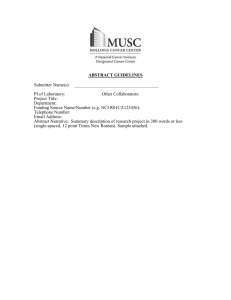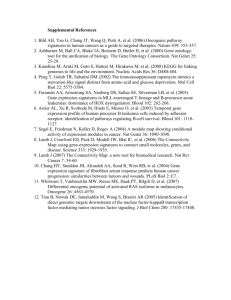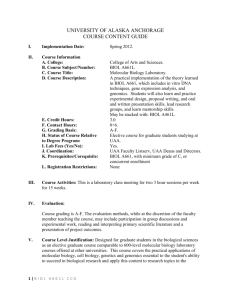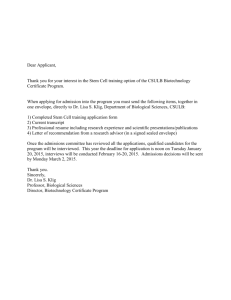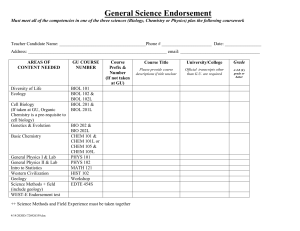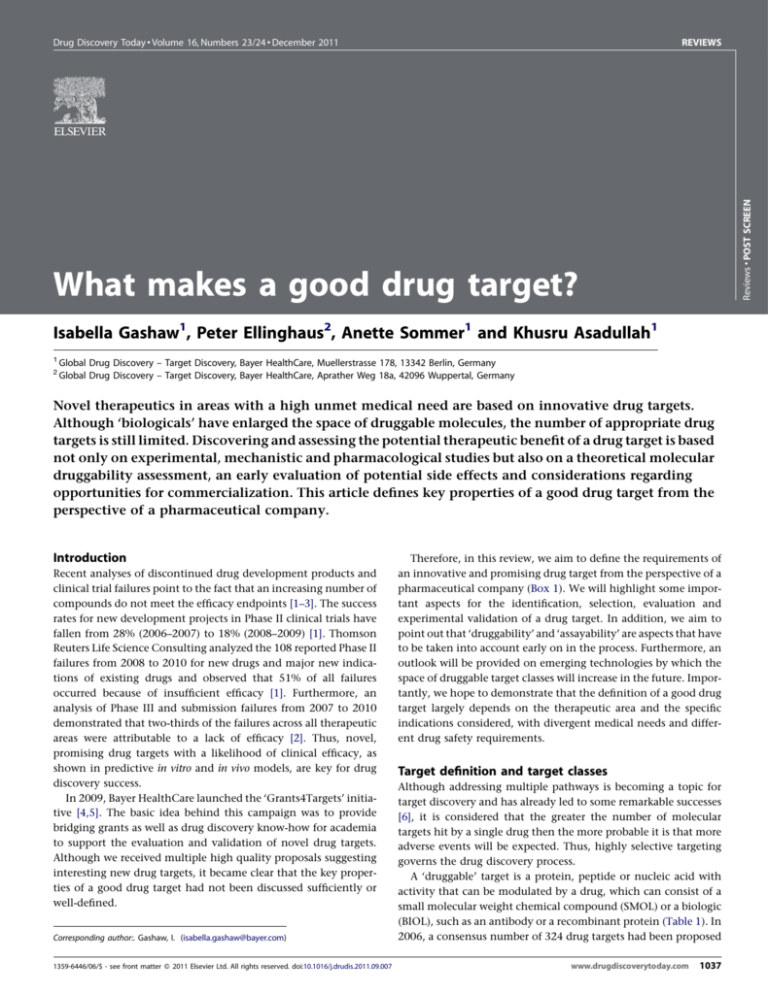
REVIEWS
Reviews POST SCREEN
Drug Discovery Today Volume 16, Numbers 23/24 December 2011
What makes a good drug target?
Isabella Gashaw1, Peter Ellinghaus2, Anette Sommer1 and Khusru Asadullah1
1
2
Global Drug Discovery – Target Discovery, Bayer HealthCare, Muellerstrasse 178, 13342 Berlin, Germany
Global Drug Discovery – Target Discovery, Bayer HealthCare, Aprather Weg 18a, 42096 Wuppertal, Germany
Novel therapeutics in areas with a high unmet medical need are based on innovative drug targets.
Although ‘biologicals’ have enlarged the space of druggable molecules, the number of appropriate drug
targets is still limited. Discovering and assessing the potential therapeutic benefit of a drug target is based
not only on experimental, mechanistic and pharmacological studies but also on a theoretical molecular
druggability assessment, an early evaluation of potential side effects and considerations regarding
opportunities for commercialization. This article defines key properties of a good drug target from the
perspective of a pharmaceutical company.
Introduction
Recent analyses of discontinued drug development products and
clinical trial failures point to the fact that an increasing number of
compounds do not meet the efficacy endpoints [1–3]. The success
rates for new development projects in Phase II clinical trials have
fallen from 28% (2006–2007) to 18% (2008–2009) [1]. Thomson
Reuters Life Science Consulting analyzed the 108 reported Phase II
failures from 2008 to 2010 for new drugs and major new indications of existing drugs and observed that 51% of all failures
occurred because of insufficient efficacy [1]. Furthermore, an
analysis of Phase III and submission failures from 2007 to 2010
demonstrated that two-thirds of the failures across all therapeutic
areas were attributable to a lack of efficacy [2]. Thus, novel,
promising drug targets with a likelihood of clinical efficacy, as
shown in predictive in vitro and in vivo models, are key for drug
discovery success.
In 2009, Bayer HealthCare launched the ‘Grants4Targets’ initiative [4,5]. The basic idea behind this campaign was to provide
bridging grants as well as drug discovery know-how for academia
to support the evaluation and validation of novel drug targets.
Although we received multiple high quality proposals suggesting
interesting new drug targets, it became clear that the key properties of a good drug target had not been discussed sufficiently or
well-defined.
Corresponding author:. Gashaw, I. (isabella.gashaw@bayer.com)
1359-6446/06/$ - see front matter ß 2011 Elsevier Ltd. All rights reserved. doi:10.1016/j.drudis.2011.09.007
Therefore, in this review, we aim to define the requirements of
an innovative and promising drug target from the perspective of a
pharmaceutical company (Box 1). We will highlight some important aspects for the identification, selection, evaluation and
experimental validation of a drug target. In addition, we aim to
point out that ‘druggability’ and ‘assayability’ are aspects that have
to be taken into account early on in the process. Furthermore, an
outlook will be provided on emerging technologies by which the
space of druggable target classes will increase in the future. Importantly, we hope to demonstrate that the definition of a good drug
target largely depends on the therapeutic area and the specific
indications considered, with divergent medical needs and different drug safety requirements.
Target definition and target classes
Although addressing multiple pathways is becoming a topic for
target discovery and has already led to some remarkable successes
[6], it is considered that the greater the number of molecular
targets hit by a single drug then the more probable it is that more
adverse events will be expected. Thus, highly selective targeting
governs the drug discovery process.
A ‘druggable’ target is a protein, peptide or nucleic acid with
activity that can be modulated by a drug, which can consist of a
small molecular weight chemical compound (SMOL) or a biologic
(BIOL), such as an antibody or a recombinant protein (Table 1). In
2006, a consensus number of 324 drug targets had been proposed
www.drugdiscoverytoday.com
1037
REVIEWS
Drug Discovery Today Volume 16, Numbers 23/24 December 2011
BOX 1
Properties of an ideal drug target:
Reviews POST SCREEN
Target is disease-modifying and/or has a proven function in the
pathophysiology of a disease.
Modulation of the target is less important under physiological
conditions or in other diseases.
If the druggability is not obvious (e.g. as for kinases) a 3D-structure
for the target protein or a close homolog should be available for a
druggability assessment.
Target has a favorable ‘assayability’ enabling high throughput
screening.
Target expression is not uniformly distributed throughout the body.
A target/disease-specific biomarker exists to monitor therapeutic
efficacy.
Favorable prediction of potential side effects according to
phenotype data (e.g. in k.o. mice or genetic mutation databases).
Target has a favorable IP situation (no competitors on target,
freedom to operate).
for all classes of approved therapeutic drugs [7]. Using bioinformatics approaches, Bakheet and Doig identified 668 proteins in
the non-target set of 3573 molecules that have target-like properties [8] thereby having the potential to become innovative targets.
However, although the vast majority of targets being currently
addressed by drug discovery are proteins, in the future nucleic
acids could gain more and more importance as drug targets [9,10].
Currently addressed target classes and the mode of action for
therapeutics are summarized in Table 1.
Target classes ‘hit’ by small molecular weight binders
SMOL drug targets mainly belong to the protein classes of
enzymes, extracellular and nuclear receptors, ion channels, and
transporters [9]. The overall growth of drug target families has
recently been analyzed applying the DrugBank database [11]. The
DrugBank database is considered one of the most important
sources of information for drugs and drug targets [12]. RaskAndersen et al. identified 435 effect-mediating drug targets in
the human genome that are modulated by 989 unique drugs,
through 2242 drug–target interactions [11]. Receptors make up
the largest group of drug targets with 193 proteins accounting for
44% of human drug targets. G-protein-coupled receptors (GPCRs)
have been commonly targeted by antihypertensive and antiallergy drugs, and represent about 36% of drug targets [11].
Despite those established drug target classes, innovative
approaches are addressing previously undruggable target classes
such as protein–protein interactions (Table 1) [13]. Moellering
et al. demonstrated that direct binding of the stapled peptide
SAHM1 prevents assembly of the active NOTCH–oncoprotein
complex [14]. More recently, the interaction between histones
and a bromodomain (BRD)-containing protein was successfully
inhibited by competitive binding and displacing the BRD4 fusion
oncoprotein from chromatin, thus controlling tumor growth or
modulating inflammatory processes [15,16]. Cutting-edge chemical approaches have identified novel mechanisms where SMOL
can activate enzyme function [17]. Hence, by applying novel
technologies the druggable space can be further broadened, which
promises additional SMOL targets in the future.
Target classes ‘hit’ by biologics
Extracellular proteins and cell surface receptors can serve as suitable targets for BIOL approaches (Table 1), which are represented
mainly by antibodies and recombinant proteins that usually do
not penetrate the cell. Most of the launched antibodies were
developed for cancer and inflammatory disease treatment. Antibody–drug conjugates (ADCs) belong to a complementary strategy
for the development of new BIOLs [18,19]. Trastuzumab-emtasine
(T-DM1, Genentech) has been developed to combine the clinical
benefits of trastuzumab (Herceptin1, Roche) with a potent microtubule-disrupting drug, and is currently being tested in multiple
clinical trials [20]. For the ADC strategy, it is not necessary that the
target itself modulates the physiology of the affected cell because
the cytotoxic agent will instigate cell killing. Thus, the idea of this
TABLE 1
Target classes addressed by SMOLs, BIOLs and nucleic acids and their modes of action
Drug
Covered target classes
Mode of action
Small molecular weight
chemical compound (SMOL)
Enzymes
Inhibitors, activatorsa
Receptors
Agonists, antagonists, modulators,
allosteric activators, sensitizers
Transcription factors
Inhibitors, activators
Biologics (BIOL)
Nucleic acids
a
Novel approaches.
1038
www.drugdiscoverytoday.com
Ion channels
Inhibitors, openers
Transport proteins
Inhibitors
Protein–protein interface
Inhibitors of protein–protein interactiona
Nucleic acids
Alkylation, complexation, intercalation
(Extracellular) proteins
Antibodies
Transmembrane receptors, extracellular proteins
Recombinant proteins
Cell surface receptors
Antibody–drug conjugates (ADCs)
Substrates and metabolites
Enzymatic cleavage
RNA
RNA interference
approach is that the antibody guides the cytotoxic agent to the
selected location on the disease tissue where the antigen is
expressed.
Target assessment
The target evaluation process at Bayer HealthCare is detailed in
Fig. 1. The successful identification of a novel drug target is
followed by detailed molecular target assessments consisting of
experimental studies on pharmacodynamic properties according
to disease hypothesis and theoretical assessments of molecular
druggability, as well as initial ideas for potential target-related
biomarkers (Fig. 1).
Target identification
The identification of a novel drug target is the first step (Fig. 2a).
One valuable source of novel targets is relevant literature because
thousands of scientists all over the world are working to unravel
novel molecular pathways and the function of genes and proteins.
Beside literature, the first hints for target properties come from
REVIEWS
descriptive studies on RNA and/or protein expression in target
tissues or from a comparison of disease versus healthy tissue.
When combined with pathway analyses and powerful data integration, expression data can provide information on potential
targets beyond those regulated by RNA or protein levels. Focused
proteomics, such as activity-based protein profiling (ABPP) [21],
enable the identification of targets based on differential enzymatic
activity in diseased versus normal tissue, further opening up the
target space. Other sources of novel target ideas are information on
genetic alterations and phenotypes of knockout mice, as well as on
somatic mutations, gene fusions and copy number variation,
especially for cancer targets.
For targets to be addressed by inhibitors or agonists, functional
genomics approaches combined with phenotypic screening are
advantageous because targets are identified in a cellular model
system and selected or engineered to reflect the disease model
more closely. The perturbation of expression of a gene (e.g. by
siRNAs or shRNAs, overexpression of cDNAs, or the inhibition
of gene function by a chemical compound) combined with
[(Figure_1)TD$IG]
Disease with high unmet medical need
Identification of a molecular drug target
Target assessment
Molecular target assessment
(experimental)
Characterization of the molecular
mechanisms addressed by the target
Adverse events
evaluation
IP/
competitors
Tissue
selectivity of
expression
Freedom to
operate
(FTO)
analysis
Phenotype data
Options for
commercialization
(ex vivo, in vitro ; e.g. siRNA, overexpr. of cells)
Modification of disease by target
modulation in a relevant in vivo model?
(e.g. using k.o./transgenic mice)
Drugability assessment
(theoretical)
SMOL binding domain existing?
Extracellular domain (for BIOL) existing?
Crystal structure available?
High-throughput assay feasible?
Ideas on target-related/stratification
biomarkers
Ensure early proof-of-concept
Clinical data
(if existing)
Common
mechanism
potential of
target
Drug class
related adverse
events
Options for
generation
of IP
Drug Discovery Today
FIGURE 1
The pillars of the target evaluation process at Bayer HealthCare.
www.drugdiscoverytoday.com
1039
Reviews POST SCREEN
Drug Discovery Today Volume 16, Numbers 23/24 December 2011
REVIEWS
Drug Discovery Today Volume 16, Numbers 23/24 December 2011
[(Figure_2)TD$IG]
Target validation
(a) Target identification strategies:
•
•
•
•
•
•
Reviews POST SCREEN
•
Gene expression profiling [21]
Focused proteomics, e.g. activity-based protein profiling [20]
Pathway analysis – pathway databases, e.g. GeneGo
Metacore & Ariadne [23,24]
Phenotype analysis – phenomic database [25,26]
Functional screening (siRNAs, shRNAs) [27]
Genetic association
Literature
(b)
Access to
models &
technologies
Drug
target
Disease
understanding
Understanding
of basic
molecular
mechanism
Drug Discovery Today
FIGURE 2
Key factors contributing to a successful target identification strategy. (a)
Target identification strategies applied at Bayer HealthCare. (b) The
relationship of disease understanding, suitable models and technologies with
basic molecular mechanisms leading to a successful identification of a
promising drug target.
The drug target has to be validated experimentally according to
the proposed mode of action. Here data link directly to the probability of clinical efficacy (i.e. experiments in human cells/tissues
of eminent importance). Functional studies can apply genetic
knockdown, knockout or, using target specific tools, if SMOL
compounds or tool antibodies are available. In vitro cell-based
mechanistic studies can be used to reveal regulative characteristics
of targets and the pathways in which they are involved. Finally,
depending on the disease, it can be necessary to evaluate the
relevance of a particular target for the disease in appropriate
animal models. Assuming that functional orthology between mice
and humans is given, and suitable disease models exist, knockout
or transgenic animals can be used for target validation. In general,
however, the translation of in vivo validation into humans is not
risk-free. Whereas some models promise to be highly predictive for
the situation in humans, others show strong discrepancies [30,31].
Moreover, some diseases are restricted to higher primates, whereas
most mechanistic animal studies are carried out in rodents. Hence,
not all indication-specific challenges can be addressed at this early
stage of drug discovery.
Translating these considerations into real drug discovery terms,
the interleukin (IL)-2-inducible tyrosine kinase (Itk) could be an
innovative concept for the therapy of inflammatory skin diseases
[32]. Itk is expressed selectively in diseased tissues. It is present
mainly in T cells and is increased in lesional skin from patients
with dermatitis. RNA silencing was applied as a target-validation
strategy and was followed by in vivo studies (i.e. in an Itk knockout
mouse model). Moreover, a SMOL inhibitor was identified that
confirmed the role of this kinase in disease models.
Druggability assessment
appropriate phenotypic readout systems in cellular model systems is a powerful method. Of these examples, high-throughput
RNAi screening technology has already contributed successfully
to target identification [22,23]. Chemical genomics approaches
are usually not as straightforward, because they require target
decoding after phenotypic screening. Sophisticated databases
that have been described previously in more detail, see Refs
[21,22,24–28], support the identification of a drug target. At
Bayer HealthCare, we integrate publicly and internally available
information on targets in the Phylosopher database (GeneData,
Basel, Switzerland) and make this database available to all scientists at Bayer HealthCare. The targets are then prioritized based
on complementary evidence from the integrated set of data.
However, when relying on published data, key results should
be replicated internally because a generally low rate of reproducibility, about 30%, of published in vitro and in vivo studies has
been experienced in-house [29].
Figure 2b lists three key factors contributing to successful target
identification: profound disease understanding, knowledge on
molecular mechanisms and the availability of predictive models
and supporting technologies. The better the disease understanding the more support is given by predictive models. We believe
that the identification of a promising drug target results from a
deep pathophysiological understanding and its causative molecular mechanisms and the application of relevant target identification and target validation technologies.
1040
www.drugdiscoverytoday.com
Current approaches to evaluate protein druggability (Fig. 1) consist of methods exploring sequence-related properties of proteins
as well as methods exploring the 3D-structures of proteins, and are
described elsewhere [24,33]. Drug targets with known 3D-structures can be located in the Potential Drug Target Database (http://
www.dddc.ac.cn/pdtd/), currently containing 1207 entries covering 841 known and potential drug targets with structures from the
Protein Data Bank (PDB) [34]. Knowing the 3D-structure is an
advantage for a drug target evaluation because it enables the
prediction of potential binding sites for SMOLs, as done by the
structure-based druggability search engine provided by EMBL-EBI
(https://www.ebi.ac.uk/chembl/drugebility).
In addition to the prediction of druggability, for a potential
SMOL target the assessment comprises the analysis of catalytic
and/or functional aspects and an analysis of selectivity issues
compared to other proteins with similar binding niches [24].
Given the 3D-structure of a protein, computational approaches,
described elsewhere [35], have been developed to estimate proteinbinding sites for ligand design that are also described elsewhere
[35].
Assayability assessment
To support a later screening program for a suitable lead compound,
biochemical and/or cellular assays for binding and function need
to be provided, which we address under the term ‘assayability’ of a
drug target. The probability of establishing a meaningful assay
Drug Discovery Today Volume 16, Numbers 23/24 December 2011
Definition of a good drug target depends on the
indication
An important aspect used to judge the validity of a given target
depends on the indication for which the target is considered. A
good example is kinase inhibitors such as Bayer’s anticancer drug
sorafenib (Nexavar1) which gains its success, at least in part, from
the multikinase inhibitory properties including serine/threonine
kinase Raf and ERK signaling [36,37]. Existing literature data [38]
also emphasize the role of Raf/MEK/ERK1/2 activation in the
process of cardiac hypertrophy [39], a major risk factor for the
development of arrhythmias, heart failure and sudden death.
However, cardiac hypertrophy is a maladaptive process initiated
early in the development of heart failure (e.g. after myocardial
infarction or by sustained elevation of blood pressure). Thus,
prevention of cardiac hypertrophy by treatment with kinase inhibitors requires an early onset of therapy and probably a life-long
treatment to prevent disease progression.
Obviously, the requirements in terms of safety and tolerability
for such a drug in a preventive setting are more challenging than
for the use of kinase inhibitors in the therapy of a life-threatening
disease such as cancer. In this respect, a PubMed search (status June
2011) linking the search terms ‘kinase & inhibitor & cardiac &
toxicity’ yielded 200 publications referring to cardiotoxicity as a
clinically important adverse event of kinase inhibitors when
administered as anticancer drugs. Consequently, seven FDAapproved kinase inhibitors have FDA label warnings regarding
possible cardiotoxicity. The adverse effects might be explained
by a dual role of multiple kinases in signaling pathways involved in
hypertrophy, and also in maintenance of normal cardiomyocyte
function or by lack of target specificity of small molecule anticancer kinase inhibitors [40]. Because the ATP-binding site is well
conserved across the kinome, it is still difficult to develop highly
specific kinase inhibitors – even with sophisticated structure biology tools. The limitations in target specificity of SMOL drugs, as
revealed for kinase inhibitors, might lead to the conclusions that a
BIOL approach – being generally more specific – could be an
attractive treatment alternative, independent of whether an antibody, a recombinant protein or even a nucleic-acid-based antisense or RNAi approach is considered. However, these three
approaches have the disadvantage that oral delivery is so far
impossible, which might be an issue for certain indications.
Finally, the costs involved for a BIOL approach exceed those of
a SMOL treatment. This could represent a higher hurdle to jump if
long-term treatment is necessary to achieve a therapeutic benefit.
Taken together, most therapeutic conditions require a specific
therapeutic option and, according to current disease understanding, it needs a careful evaluation whether a multiple target
approach is to be preferred or whether the one-drug-one-target
guidance needs to be followed [11].
Clinical and commercial needs
Key aspects to be considered are a high unmet medical need (no
drug is available or existing therapies have serious limitations with
regard to efficacy or safety or both) and there is a reasonable
market size.
The full therapeutic potential of many drug targets is often not
obvious at the time of their discovery. A good example is the ratelimiting enzyme of the cholesterol biosynthetic pathway, HMGCoA reductase, the target that the pharmaceutical industry has
generated its highest sales from all drug targets until today [41].
During early research on this enzyme, some investigators were led
astray by the fact that the first inhibitor, compactin, did not lower
plasma cholesterol in the rat, which was later shown to result from
massive induction of HMG-CoA in rat liver by inhibitors of the
enzyme. It took more than 20 years from the idea conception
regarding inhibition of HMG-CoA reductase for cholesterol lowering until the first clinical results confirmed the validity of this drug
target [42]. Sometimes favoring ‘fail early – fail cheap’ modulation of
a target should reveal, early in the process of target validation, that a
therapeutic effect can be achieved, ideally already by phenotypic
assays in vitro or at the latest by in vivo experiments.
Even if a target has been successfully validated for an indication,
it might be necessary to broaden its therapeutic use by looking for
additional indications in which it might also have a role, a term we
refer to as ‘common mechanism potential’ (Fig. 1). This allows for
broadening of the therapeutic landscape of a drug or to shift a
target if, in later phases of development, difficulties arise for the
anticipated indication.
The intellectual property situation
As described by others [43,44], the contribution of a pharmaceutical company to the value chain is a patentable chemical compound (or BIOL) that becomes a drug rather than the target itself.
The ideal – but often not achievable – is the combination of both: a
patent-protected compound (be it a BIOL or a SMOL) and a patent
for the use of modulators against a target for the treatment of
specified diseases.
An early analysis of ‘freedom-to-operate’ (FTO) ensures that a
particular action, such as development of an assay to identify
modulators for the target, can be done without infringing the
valid intellectual property rights of others.
A novel target promises that there is an opportunity – if chemical
space allows – to file a new patent on the SMOL compound interfering with the target and thereby generating intellectual property.
The full return on investment can only be achieved if the company
has the exclusive rights for the commercial use of a modulator
against the target, accompanied by the payment of royalties to
external inventors for their contribution to the marketed drug.
The same is true for the protection of compounds and/or antibodies
that modulate the target: If we do not have a patent-protected SMOL
or BIOL we cannot defend ourselves against competitors.
Generally, because many targets are initially identified in scientific literature, there is a direct relationship between the degree of
validation and the competition around a given target. Some
companies are more risk averse in selecting targets and are willing
to accept greater competition, whereas other companies are willing to accept more scientific risk to reduce competition in the hope
of developing a first-in-class drug.
www.drugdiscoverytoday.com
1041
Reviews POST SCREEN
depends on target class and the information on the target. Because
the activity status of many GPCRs can be monitored easily by
measurements of second messenger levels, a de-orphaned GPCR
target can be expected to have a favorable assayability, whereas, by
contrast, an orphan GPCR will probably yield a low assayability
despite the fact that the druggability is not questionable. In this
case, functional studies need to be provided and formatted into
pharmacologically relevant assays.
REVIEWS
REVIEWS
Early evaluation of potential adverse events
Reviews POST SCREEN
Owing to pleiotropic effects, the same target might have different
functions in different organ systems or at different time points
during development and adulthood. It is therefore helpful to have
a look at the expression level of the desired target throughout the
human body. Although there are some exceptions, it can be
assumed that the broader the expression the higher the risk for
adverse events when the drug has to be administered systemically.
Differential expression in samples representing human disease
versus healthy controls is an additional parameter contributing
to an early assessment of putative target-related adverse events. As
an example, the extremely high tolerability of proton pump
inhibitors for the treatment of gastric reflux diseases is largely
explained by the near exclusive expression of their molecular
target – the gastric H+/K+ ATPase – in gastric mucosa. The relative
importance of these descriptive criteria, however, varies between
the individual indications. Obviously, the tolerability for targetrelated undesired effects is considerably higher in life-threatening
oncologic conditions than in less devastating diseases.
Further hints for potential adverse events can be obtained from
data on knockout mice and from genetic deficiencies in humans.
For example, the inhibitors of the mitochondrial enzyme dihydroorotate-dehydrogenase (DHODH) that are being developed for
rheumatoid arthritis are known for their teratogenic potential, as
demonstrated in mice [45]. Recent studies applying the new
technology of exome sequencing identified that mutations in
the DHODH gene are the cause for Miller syndrome, a rare Mendelian disorder, which is characterized by severe craniofacial and
limb anomalies [46]. Thus, early access to those human genedisease-association data could contribute to the early awareness
of potential undesired target-related effects.
Known phenotypes can be easily discovered in the database
provided by Jackson laboratories (http://www.informatics.jax.org/
). To overcome embryonic lethality of the homozygous null animal
tissue, restricted and/or inducible knockouts can be produced. To
evaluate the phenotype of mutant mouse lines, the German Mouse
Clinic (GMC) has been established at Helmholtz Zentrum München
as a phenotyping platform with open access for the scientific community [47]. Such phenotyping studies on knockout mice are useful
to evaluate potential target-related adverse events that can arise
when the drug target is strongly or irreversibly inhibited.
Detailed studies of existing clinical data are helpful when considering a new indication for a known target. For example, the
Therapeutic Target Database (TTD) has been developed to provide
information about therapeutic targets and corresponding drugs [48].
Drug Discovery Today Volume 16, Numbers 23/24 December 2011
drugs and major new indications of existing drugs were successful and more than 50% of Phase II failures occurred as a result of
insufficient efficacy [1]. In this respect, early considerations for
mechanistic biomarkers confirming the mode of action are of
crucial interest to validate a target:
If the mechanistic biomarker reveals that the target was insufficiently ‘hit’ by the drug, this might favor the search for better lead
structures. However, if the biomarker confirms a sufficient modulation of the target/pathway – but without any net clinical benefit –
the questions arise as to whether the target/pathway is valid at all. A
good example how such a mechanistic biomarker can help to judge
the validity of a target is the development of angiotensin-II receptor
antagonists for the treatment of hypertension: In Phase I trials, no
blood-pressure-lowering effect after compound treatment can be
expected in healthy volunteers but a compensatory increase of
plasma renin activity could already be observed in healthy volunteers ensuring that the pathway was also affected in humans [49].
Thus, the risk that the compound cannot achieve the therapeutic
goal in a later Phase II trial because the pathway is irrelevant in
humans is reduced. Therefore, we recommend to consider putative
mechanistic biomarkers for the validation of a target as early as
possible, ideally in preclinical animal experiments. The potential of
biomarkers and their use has been recently reviewed elsewhere [50].
All in vivo target validation approaches should, whenever possible, also incorporate available tool compounds or established
drug treatments. As an example, a new drug target in cancer
should not only be validated by examination of its effect on tumor
weight in either transgenic or knockout mice but it should also be
evaluated if the effect is still observed on top of treatment with
established anticancer drugs; a situation that a modulator of the
respective target has to face in the clinical setting as well. Box 1
summarizes the key properties of a good drug target.
Concluding remarks
The present manuscript provides the point of view on target
selection criteria and target validation options from the perspective of scientists at Bayer HealthCare. However, there are different
perspectives on target selection that relate to the degree of validation, clinical area, unmet need, competition and intellectual
property, particularly across small, medium and large companies.
We believe that a thoroughly performed target validation
should help to reduce attrition rates in the later stages of drug
development. In this respect, the best SMOL or BIOL against a new
drug target is dispensable if the initial disease hypothesis is invalid.
Disclosure statement
From bench to bedside and vice versa
A major drawback in target validation arises from the fact that
the validity of a given target in a specific disease can only finally
be judged after a clinical ‘proof-of-concept’ trial. As mentioned
above, only 18% of Phase II studies from 2008 to 2010 for new
The authors are employees of Bayer HealthCare.
Acknowledgements
The authors gratefully acknowledge the helpful comments of
Monika Lessl and Martin Schneider.
References
1 Arrowsmith, J. (2011) Trial watch: phase II failures: 2008–2010. Nat. Rev. Drug
Discov. 10, 328–329
2 Arrowsmith, J. (2011) Trial watch: phase III and submission failures: 2007–2010.
Nat. Rev. Drug Discov. 10, 87
1042
www.drugdiscoverytoday.com
3 Graul, A.I. and Cruces, E. (2011) The year’s new drugs & biologics, 2010. Drugs Today
(Barc.) 47, 27–51
4 Lessl, M. et al. (2011) Crowd sourcing in drug discovery. Nat. Rev. Drug Discov. 10,
241–242
5 Lessl, M. et al. (2011) Grants4Targets – an innovative approach to translate ideas
from basic research into novel drugs. Drug Discov. Today 16, 288–292
6 Hopkins, A.L. (2008) Network pharmacology: the next paradigm in drug discovery.
Nat. Chem. Biol. 4, 682–690
7 Overington, J.P. et al. (2006) How many drug targets are there? Nat. Rev. Drug Discov.
5, 993–996
8 Bakheet, T.M. and Doig, A.J. (2009) Properties and identification of human protein
drug targets. Bioinformatics 25, 451–457
9 Imming, P. et al. (2006) Drugs, their targets and the nature and number of drug
targets. Nat. Rev. Drug Discov. 5, 821–834
10 Davidson, B.L. and McCray, P.B., Jr (2011) Current prospects for RNA interferencebased therapies. Nat. Rev. Genet. 12, 329–340
11 Rask-Andersen, M. et al. (2011) Trends in the exploitation of novel drug targets. Nat.
Rev. Drug Discov. 10, 579–590
12 Knox, C. et al. (2011) DrugBank 3.0: a comprehensive resource for ‘omics’ research
on drugs. Nucleic Acids Res. 39 (Database issue), 1035–1041
13 Wells, J.A. and McClendon, C.L. (2007) Reaching for high-hanging fruit in drug
discovery at protein–protein interfaces. Nature 450, 1001–1009
14 Moellering, R.E. et al. (2009) Direct inhibition of the NOTCH transcription factor
complex. Nature 462, 182–188
15 Filippakopoulos, P. et al. (2010) Selective inhibition of BET bromodomains. Nature
468, 1067–1073
16 Nicodeme, E. et al. (2010) Suppression of inflammation by a synthetic histone
mimic. Nature 468, 1119–1123
17 Zorn, J.A. and Wells, J.A. (2010) Turning enzymes ON with small molecules. Nat.
Chem. Biol. 6, 179–188
18 Webb, S. (2011) Pharma interest surges in antibody drug conjugates. Nat. Biotechnol.
29, 297–298
19 Hughes, B. (2010) Antibody–drug conjugates for cancer: poised to deliver? Nat. Rev.
Drug Discov. 9, 665–667
20 Junttila, T.T. et al. (2011) Trastuzumab-DM1 (T-DM1) retains all the mechanisms of
action of trastuzumab and efficiently inhibits growth of lapatinib insensitive breast
cancer. Breast Cancer Res. Treat. 128, 347–356
21 Sieber, S.A. and Cravatt, B.F. (2006) Analytical platforms for activity-based protein
profiling – exploiting the versatility of chemistry for functional proteomics. Chem.
Commun. (Camb.) 22, 2311–2319
22 Nakayama, H. et al. (2009) Ariadne: a database search engine for identification and
chemical analysis of RNA using tandem mass spectrometry data. Nucleic Acids Res.
37, 47
23 Henderson, M.C. et al. (2011) High-throughput RNAi screening identifies a role for
TNK1 in growth and survival of pancreatic cancer cells. Mol. Cancer Res. 9, 724–732
24 Egner, U. et al. (2005) The target discovery process. Chembiochem 6, 468–479
25 Toyoda, T. and Wada, A. (2004) Omic space: coordinate-based integration and
analysis of genomic phenomic interactions. Bioinformatics 20, 1759–1765
26 Ekins, S. et al. (2007) Pathway mapping tools for analysis of high content data.
Methods Mol. Biol. 356, 319–350
27 Groth, P. et al. (2010) Phenoclustering: online mining of cross-species phenotypes.
Bioinformatics 26, 1924–1925
28 Groth, P. et al. (2008) Mining phenotypes for gene function prediction. BMC
Bioinformatics 9, 136
REVIEWS
29 Prinz, F. et al. (2011) Believe it nor not – how much can we rely on published data?
Nat. Rev. Drug Discov. 10 (9), 712. doi: 10.1038/nrd3439-c1
30 Wendler, A. and Wehling, M. (2010) The translatability of animal models for
clinical development: biomarkers and disease models. Curr. Opin. Pharmacol. 10,
601–606
31 Dolgin, E. (2010) Animalgesic effects. Nat. Med. 16, 1237–1240
32 von Bonin, A. et al. (2011) Inhibition of the IL-2-inducible tyrosine kinase (Itk)
activity: a new concept for the therapy of inflammatory skin diseases. Exp. Dermatol.
20, 41–47
33 Egner, U. and Hillig, R.C. (2008) A structural biology view of target drugability.
Expert Opin. Drug Discov. 3, 391–401
34 Gao, Z. et al. (2008) PDTD: a web-accessible protein database for drug target
identification. BMC Bioinformatics 9, 104
35 Henrich, S. et al. (2010) Computational approaches to identifying and
characterizing protein binding sites for ligand design. J. Mol. Recognit. 23, 209–219
36 Wilhelm, S.M. et al. (2008) Preclinical overview of sorafenib, a multikinase inhibitor
that targets both Raf and VEGF and PDGF receptor tyrosine kinase signaling. Mol.
Cancer Ther. 7, 3129–3140
37 Takimoto, C.H. and Awada, A. (2008) Safety and anti-tumor activity of sorafenib
(Nexavar) in combination with other anti-cancer agents: a review of clinical trials.
Cancer Chemother. Pharmacol. 61, 535–548
38 Muchir, A. et al. (2009) Inhibition of extracellular signal-regulated kinase signaling
to prevent cardiomyopathy caused by mutation in the gene encoding A-type
lamins. Hum. Mol. Genet. 18, 241–247
39 Lorenz, K. et al. (2009) Cardiac hypertrophy: targeting Raf/MEK/ERK1/2-signaling.
Int. J. Biochem. Cell Biol. 41, 2351–2355
40 Hasinoff, B.B. and Patel, D. (2010) The lack of target specificity of small molecule
anticancer kinase inhibitors is correlated with their ability to damage myocytes in
vitro. Toxicol. Appl. Pharmacol. 249, 132–139
41 Li, J.J., ed. (2009) Triumph of the Heart: The Story of Statins, Oxford University Press
42 Tobert, J.A. (2003) Lovastatin and beyond: the history of the HMG-CoA reductase
inhibitors. Nat. Rev. Drug Discov. 2, 517–526
43 Lipinski, C.A. (2006) The anti-intellectual effects of intellectual property. Curr. Opin.
Chem. Biol. 10, 380–383
44 Munos, B. (2009) Lessons from 60 years of pharmaceutical innovation. Nat. Rev.
Drug Discov. 8, 959–968
45 Fukushima, R. et al. (2009) Inhibiting the teratogenicity of the immunosuppressant
leflunomide in mice by supplementation of exogenous uridine. Toxicol. Sci. 108,
419–426
46 Ng, S.B. et al. (2010) Exome sequencing identifies the cause of a mendelian disorder.
Nat. Genet. 42, 30–35
47 Gailus-Durner, V. et al. (2009) Systemic first-line phenotyping. Methods Mol. Biol.
530, 463–509
48 Zhu, F. et al. (2010) Update of TTD: therapeutic target database. Nucleic Acids Res. 38
(Database issue), 787–791
49 Ohtawa, M. et al. (1993) Pharmacokinetics and biochemical efficacy after single and
multiple oral administration of losartan, an orally active nonpeptide angiotensin II
receptor antagonist, in humans. Br. J. Clin. Pharmacol. 35, 290–297
50 Asadullah, K. and Kramer, F. (2011) Biomarkers for intensive care medicine patients:
the (stony) path into a bright future? Biomarkers 16 (Suppl. 1), 1–4
www.drugdiscoverytoday.com
1043
Reviews POST SCREEN
Drug Discovery Today Volume 16, Numbers 23/24 December 2011

